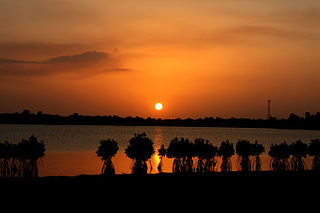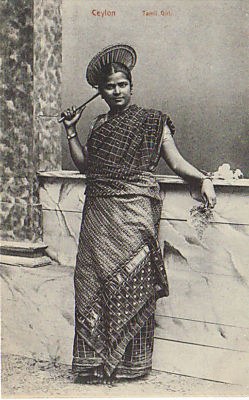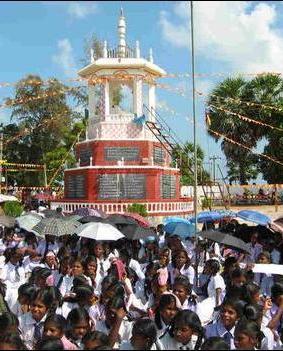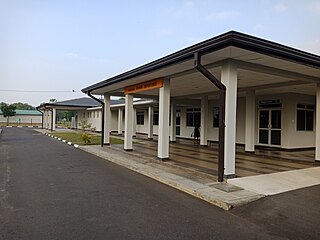Related Research Articles

The Sri Lankan Civil War was a civil war fought in Sri Lanka from 1983 to 2009. Beginning on 23 July 1983, it was an intermittent insurgency against the government by the Velupillai Prabhakaran-led Liberation Tigers of Tamil Eelam. The LTTE fought to create an independent Tamil state called Tamil Eelam in the north-east of the island, due to the continuous discrimination and violent persecution against Sri Lankan Tamils by the Sinhalese-dominated Sri Lanka government.

The Special Task Force (STF) (Sinhala: විශේෂ කාර්ය බලකාය Visesha Karya Balakaya; Tamil: சிறப்பு அதிரடிப் படை) is an elite police tactical unit of the Sri Lanka Police specialising in clandestine and covert operations, combat and patrolling in urban areas, combat search and rescue, counterinsurgency and counterterrorism operations, crowd control, executive protection, forward observer, hostage rescue, indirect fire, irregular warfare, jungle and mountain warfare, parachuting, psychological warfare, search and rescue people who are in distress or imminent danger from disaster. serving high-risk arrest and search warrants, special reconnaissance, support military operations, tactical emergency medical, tracking, and unconventional tactics. It was formed in 1983 not as a military force, but rather as a highly specialised armed police unit.
Tamil Makkal Viduthalai Pulikal (TMVP), previously known as the "Karuna Group", is a political party in Sri Lanka. It was formed by Karuna Amman, a former leader of the Liberation Tigers of Tamil Eelam, after he defected from the organization in 2004. Initially a paramilitary group that helped the Sri Lankan Government fight the Tamil Tigers, the TMVP was registered as a political party in 2007. Under deputy leader Pillayan, they contested their first provincial elections in 2008, winning a majority in the Eastern Provincial Council. Members of the TMVP continue to carry arms under the auspices of the Sri Lankan government, which they claim is for their own safety from the Tamil Tigers, who carry out repeated attacks against them. The group is believed to be working with the Sri Lankan Army. They have been accused of human rights violation by local and international human rights organization.

Batticaloa is a major city in the Eastern Province, Sri Lanka, and its former capital. It is the administrative capital of the Batticaloa District. The city is the seat of the Eastern University of Sri Lanka and is a major commercial centre. It is on the east coast, 111 kilometres (69 mi) south of Trincomalee, and is situated on an island. Pasikudah is a popular tourist destination situated 35 km (22 mi) northwest with beaches and flat year-round warm-water shallow-lagoons.

The Eastern Province is one of the nine provinces of Sri Lanka, the first level administrative division of the country. The provinces have existed since the 19th century but did not have any legal status until 1987 when the 13th Amendment to the Constitution of Sri Lanka established provincial councils. Between 1988 and 2006 the province was temporarily merged with the Northern Province to form the North Eastern Province. The capital of the province is Trincomalee. Kalmunai is the largest and most populous city of Eastern Province.

Sri Lankan Tamils, also known as Ceylon Tamils or Eelam Tamils, are Tamils native to the South Asian island state of Sri Lanka. Today, they constitute a majority in the Northern Province, form the plurality in the Eastern Province and are in the minority throughout the rest of the country. 70% of Sri Lankan Tamils in Sri Lanka live in the Northern and Eastern provinces.
Human rights in Sri Lanka provides for fundamental rights in the country. The Sri Lanka Constitution states that every person is entitled to freedom of thought, conscience and religion, including the freedom to have or to adopt a religion or belief of his choice. And, that every person is equal before the law.
The 1990 Batticaloa massacre, also known as the Sathurukondan massacre, was a massacre of at least 184 minority Sri Lankan Tamil refugees, including infants, from three villages in the Batticaloa District by the Sri Lankan Army on September 9, 1990. Although the government instituted two investigations, no one was ever charged.
The Eastern University massacre was the arrest and subsequent mass murder of 158 minority Sri Lankan Tamil refugees who had taken refuge in the Eastern University campus close to the city Batticaloa on September 5, 1990. A witness identified Sri Lankan Army personnel as the perpetrators. The event is part of what is known amongst Sri Lankan Tamils as Black September, a series of civilian massacres. The Sri Lankan government eventually established a presidential commission of inquiry. The inquiry found evidence of illegal abductions and mass murder. It also named the responsible parties, but there is currently no evidence of any judicial follow up to the inquiry.

Aiyathurai Nadesan, a prominent and veteran minority Sri Lankan Tamil journalist was shot dead on 31 May 2004 on his way to work in eastern Sri Lankan town of Batticaloa by gunmen belonging to an armed paramilitary group widely believed to be so called Karuna Group.

On June 12, 1991, 152 minority Sri Lankan Tamil civilians were massacred by members of the Sri Lankan military in the village Kokkadichcholai near the eastern province town of Batticaloa. The Sri Lankan government instituted a presidential commission to investigate the massacre. The commission found the commanding officer negligent in controlling his troops and recommended that he be removed from office, and identified nineteen other members of the Sri Lankan military to be responsible for mass murder. In a military tribunal that followed in the presidential commission in the capital city of Colombo, all nineteen soldiers were acquitted.

Batticaloa International Airport, formerly known as Batticaloa Airport, is an airport serving eastern Sri Lanka. It is also a military airbase known as Sri Lanka Air Force Batticaloa or SLAF Batticaloa. The airport is located in the village of Puthunagar on the island of Thimilathiu, 1 nautical mile south-west of the city of Batticaloa. It resides at an elevation of 3 m (10 ft) and has one runway designated 06/24 with a bitumen surface measuring 1,560 by 46 metres.

Eelam War II is the name given to the second phase of armed conflict between Sri Lankan military and the separatist Liberation Tigers of Tamil Eelam. The war started after the failure of peace talks between the Premadasa government and the LTTE. This phase of the war was initiated by the LTTE who massacred almost 600 Sinhalese and Muslim police personnel after they were ordered by the Premadasa government to surrender to the LTTE. The truce was broken on June 10, 1990 when the LTTE in October expelled all the 28,000 Muslims residing in Jaffna.

Eelam War IV is the name given to the fourth phase of armed conflict between the Sri Lankan military and the separatist Liberation Tigers of Tamil Eelam (LTTE). Renewed hostilities began on the 26 July 2006, when Sri Lanka Air Force fighter jets bombed several LTTE camps around Mavil Aru anicut. The government's casus belli was that the LTTE had cut off the water supply to surrounding paddy fields in the area. Shutting down the sluice gates of the Mavil Aru on July 21 depriving the water to over 15,000 people - Sinhalese and Muslim settlers under Sri Lankan state-sponsored colonisation schemes in Trincomalee district. They were denied of water for drinking and also cultivating over 30,000 acres of paddy and other crops. The fighting resumed after a four-year ceasefire between the Government of Sri Lanka (GoSL) and LTTE. Continued fighting led to several territorial gains for the Sri Lankan Army, including the capture of Sampur, Vakarai and other parts of the east. The war took on an added dimension when the LTTE Air Tigers bombed Katunayake airbase on March 26, 2007, the first rebel air attack without external assistance in history.

Batticaloa District is one of the 25 districts of Sri Lanka, the second level administrative division of the country. The district is administered by a District Secretariat headed by a District Secretary appointed by the central government of Sri Lanka. The capital of the district is the city of Batticaloa. Ampara District was carved out of the southern part of Batticaloa District in April 1961.

Eugene John Hebert was an American-born Jesuit missionary in Sri Lanka. He along with his Tamil driver Betram Francis disappeared on August 15, 1990 as the Sri Lankan civil war was raging. He went missing on his way to the eastern city of Batticaloa from a nearby town of Valaichchenai. He was known for his Human Rights activity on behalf of the local civilians. The Jesuits believe that he was killed along with his driver.
The American-Batticaloa Development Fund (ABDF.org) is a small American-based non-profit development organization operating in the Batticaloa District of Sri Lanka. The organization sponsors a series of low-cost micro-development projects with the objective of improving the lives of recipients in an immediate and tangible way. Projects range from supplying clean drinking water, providing electricity, building roads, and supplying materials for schools.

The 1987 Eastern Province massacres were a series of massacres of the Sinhalese population in the Eastern Province of Sri Lanka by Tamil mobs and Liberation Tigers of Tamil Eelam (LTTE) during the Sri Lankan Civil War. Though they began spontaneously, they became more organized, with the LTTE leading the violence. Over 200 Sinhalese were killed by mob and militant violence, and over 20,000 fled the Eastern Province. The violence has been described as having had the appearance of a pogrom.
Sexual violence against Tamils in Sri Lanka has occurred repeatedly during the island's long ethnic conflict. The first instances of rape of Tamil women by Sinhalese mobs were documented during the 1958 anti-Tamil pogrom. This continued in the 1960s with the deployment of the Sri Lankan Army in Jaffna, who were reported to have molested and occasionally raped Tamil women.
References
- Santa Barbara, Joanna - The Butterfly Peace Garden; Croatian Medical Journal 45(2):232-233,2004
- Chase, Robert - The Butterfly Garden, Batticaloa, Sri Lanka: Final Report of a Program Development and Research Project, 1998-2000. Ratmalana, Sri Lanka: Sarvodaya;2000.